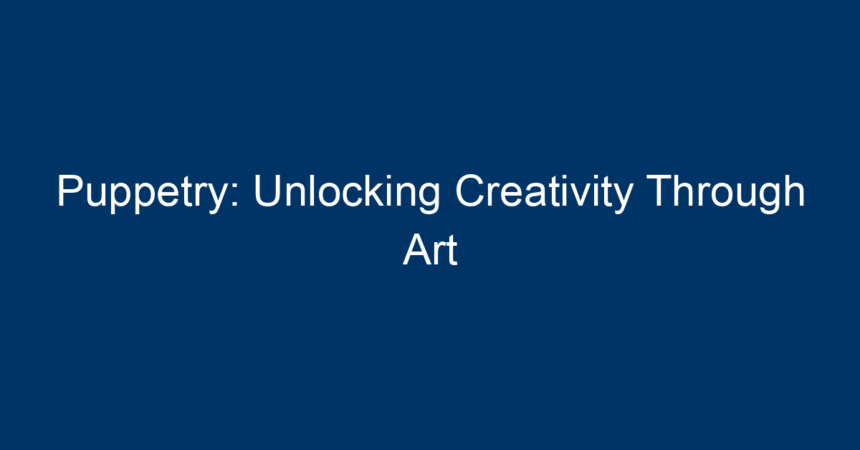Puppetry is more than just a form of entertainment; it is a unique medium that combines artistry, storytelling, and creativity. This art form encourages both children and adults to express themselves in imaginative ways, fostering creativity that transcends age and background. In this article, we will explore the fascinating world of puppetry, delve into its various forms, and uncover how it can unlock creativity within individuals and communities alike.
What is Puppetry?
Puppetry is the art of manipulating puppets to convey a story or message. This age-old practice has been present in various cultures around the world, from the marionettes of Europe to the shadow puppets of Asia. Whether performed in theaters, schools, or workshops, puppetry is a versatile medium that can be used for education, entertainment, or therapy.
The Historical Roots of Puppetry
Puppetry has a rich history that dates back thousands of years. It is believed to have originated in ancient Greece, where puppets were used for religious ceremonies and entertainment. Over time, the art form spread across the globe, adopting local cultural elements and techniques. Today, puppetry is celebrated in many forms, such as:
- Marionette Puppetry: Controlled by strings, these puppets create a lifelike performance that captivates audiences.
- Hand Puppetry: Ideal for storytelling, hand puppets are simple yet expressive, inviting imagination.
- Shadow Puppetry: Utilizing light and shadows, this form offers a captivating visual experience.
The Power of Puppetry in Sparking Creativity
Puppetry acts as a powerful vehicle for self-expression and creativity. Here are several ways puppetry helps unlock artistic potential:
1. Encouraging Imagination
Creating and performing with puppets requires a significant amount of imagination. In a world where screens dominate our attention, puppetry offers a tactile experience that transports individuals into a realm of fantasy. Children learn to visualize characters, settings, and plots, igniting their creative sparks.
2. Storytelling Skills
Puppetry serves as a medium for storytelling. Crafting a narrative for puppets allows individuals to explore character development, plot structure, and emotional arcs. By bringing stories to life, puppet creators not only enhance their storytelling skills but also learn how to convey complex themes in relatable ways.
3. Collaborative Creativity
Puppetry is often a communal activity, requiring collaboration among friends, family, or classmates. Working together on a puppet show fosters teamwork and encourages participants to share ideas and build off one another’s creativity. This collaborative aspect reinforces social skills and enhances creative thinking.
4. Emotional Expression
For many, puppetry serves as an emotional outlet. Manipulating puppets allows individuals to explore feelings that may be difficult to articulate verbally. This can be particularly beneficial for children who are still learning how to express their emotions constructively. Puppets act as intermediaries, providing a safe space to explore complex feelings.
Techniques and Materials for Puppetry
To embark on your puppetry journey, understanding various techniques and materials is essential. Below are some popular methods and tools to get you started.
Materials for Puppet-Making
- Fabric: Felt, cotton, and other textiles can be used to construct various puppet styles.
- Wood: For marionettes or sturdier puppets, wood is an excellent option.
- Plastic: Lightweight and durable, plastic can be molded into intricate shapes.
- Paper: Perfect for shadow puppetry, paper can be cut and decorated for various effects.
- Recyclable Items: Items like socks, cardboard, and plastic bottles can be repurposed into creative puppets.
Techniques for Puppet Control
- String Control (Marionettes): Requires precision and practice to control the movements of the puppet.
- Hand Control (Hand Puppets): Offers immediate feedback, allowing for spontaneous storytelling.
- Light Control (Shadow Puppetry): Involves creating silhouettes against a light source for dramatic effects.
The Benefits of Puppetry in Education
Integrating puppetry into educational settings can profoundly impact students’ learning experiences.
1. Engaging Learning
Puppetry captures students’ attention, making learning more engaging. It can be used to teach subjects like history, science, and language arts in a fun format that resonates with students.
2. Enhancing Communication Skills
Puppetry encourages effective communication—both verbal and non-verbal. Students learn to articulate their thoughts clearly, presenting ideas confidently through their puppets.
3. Boosting Confidence
Performing in front of an audience, even if it’s just a classroom, helps build self-esteem. The act of bringing a puppet to life can empower individuals, making them more comfortable with public speaking.
4. Fostering Critical Thinking
Creating stories and characters stimulates critical thinking and problem-solving skills. Students engage in brainstorming sessions and develop their ideas, promoting analytical thinking.
Puppetry as a Therapeutic Tool
Beyond its artistic and educational benefits, puppetry can be an effective therapeutic tool. Therapists often use puppetry in counseling sessions to help clients explore emotions and communicate more freely.
1. Expressing Complex Emotions
Puppets can help individuals articulate feelings they may find challenging to express. They can serve as stand-ins for the individual’s thoughts and emotions, providing a layer of distance that can make it easier to discuss sensitive topics.
2. Building Connections
Puppetry creates an opportunity for connection between therapist and client. It encourages trust and openness, fostering deeper emotional bonds.
3. Reducing Anxiety
Engaging with puppets can reduce anxiety, especially in children. The playful aspect of puppetry creates a relaxed environment conducive to healing and self-discovery.
How to Get Started with Puppetry
If you’re inspired to explore puppetry, here are some actionable steps to embark on your artistic journey:
1. Gather Your Materials
Start collecting materials you can use for puppet-making. Look around your house for fabric, recyclable items, and any other creative supplies.
2. Learn Puppet-Making Techniques
Research various puppet-making tutorials online or attend local workshops. Many community centers offer classes that introduce the basics of puppetry.
3. Create a Puppet
Begin by making a simple hand puppet. Experiment with different designs and materials until you find a character you love.
4. Write a Story
Develop a short story that incorporates your puppet character. Focus on character development and ensure there’s a conflict or moral lesson.
5. Perform and Share
Once you’re comfortable, perform your puppet show for family or friends. Invite feedback and enjoy the sharing process.
Conclusion: Embrace the Art of Puppetry
Puppetry is a powerful medium that unlocks creativity, promotes emotional expression, and fosters collaboration. By integrating puppetry into various aspects of life—be it education, therapy, or personal exploration—individuals can experience profound growth and joy.
As you explore the world of puppetry, remember that each puppet holds the potential to tell a story, convey emotions, and inspire creativity. So grab some materials, delve into the imaginative realm of puppetry, and let your creativity flourish!
By focusing on the multifaceted nature of puppetry and its impact on creativity and community, this article not only addresses enthusiasts but also encourages beginners to explore their artistic potential. If you’re ready to turn ideas into performances, puppetry is waiting for you!




